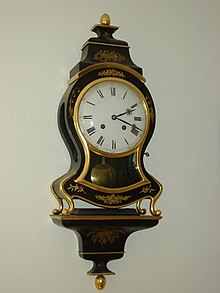Pendulum clock
![]()
The title of this article is ambiguous. For a constellation of the same name, see Pendulum clock (constellation).
The pendulum clock, also called pendulum or pendulum, is a clock whose clock is a mechanical pendulum (also obsolete: perpendicular). The oscillation of the pendulum sets the time, an approx. 1 m long pendulum (exactly 0.994 m) swings in 1 second from one side to the other. The shorter the pendulum, the more often it swings per second.
Pendulum clocks come in various forms, in particular as tower clocks, wall clocks, table clocks or floor clocks. Because of the interference to the pendulum movement caused by external accelerations, they are generally not suitable for moving clocks, such as wristwatches or clocks on vehicles.
Galileo Galilei formulated the law of the pendulum in 1632, which in its original form states that the period of oscillation of a pendulum is independent of its weight and depends only on the length of the pendulum. By this Galileo also meant that the period of oscillation does not depend on the amplitude of the oscillation (isochronism), but this is only true in the limiting case of small oscillations. These properties of a pendulum are the prerequisite for the construction of pendulum clocks. Galileo's son Vincenzio tried (without success) to build a pendulum clock.
It was also around this time that Christiaan Huygens (inventor of the balance with hairspring, among other things) was concerned with the theory and construction of the pendulum clock. The first (functioning) pendulum clock with spindle escapement constructed by Huygens, which is now kept in the Rijksmuseum in Leiden, was built by the master craftsman Salomon Coster in 1657. It had an inaccuracy of about ±10 s per day. This value could only be improved to less than one second per day 100 years later, when John Harrison constructed his Time Keeper No. 4, which, however, has a balance instead of a pendulum.

Pendulum clock in the Villa Hammerschmidt

Sumiswald pendulum (stick clock), ca. 1850-1870
.jpg)
German pendulum clock of the 19th century, brand Gustav Eduard Becker

Pendulum Louis XV, by Mathäus Funk (around 1745)
Description
The principle of the pendulum clock is based on the fact that a swinging or rotating pendulum triggers an action in the movement at a certain point in its travel each time it passes, thereby advancing the time display (this is most frequently done by the ascending wheel and escapement). In addition, the pendulum receives an impulse (lift) from the movement or another drive so that the oscillation is maintained despite the loss of energy due to friction.
The uniformity of the pendulum's motion is determinative of the clock's rate accuracy, which is why great attention is paid to the construction of the pendulum and the triggering of the action in the movement. The friction of the pendulum suspension was soon reduced by agate bearings, wobbling was lessened by pendulum springs, the even transmission of force to the pendulum was improved by a pendulum rod, and air resistance was lessened by sleek pendulum lenses. Changing external influences on the period of oscillation, such as temperature, air density and humidity, can be compensated for. Low-friction triggering of the movement and uniform impulse transmission from the movement to the pendulum are further prerequisites for good rate results.
The adjustment of the period of oscillation of pendulum clocks is done by changing the effective pendulum length.
→ Main article: Seconds pendulum
Brief history
- In 1637 Galileo Galilei already saw the possibility of measuring time with a pendulum clock, but without building a corresponding clock. His son constructed a preliminary form of the pendulum clock, but did not measure time with it, instead using the device to measure vibrations.
- In 1657 Christiaan Huygens patented an escapement that improved the accuracy to ten seconds per day.
- In the 1680s, hook and lever escapements were invented and the pendulum suspension on the thread was replaced by a thin steel spring (pendulum spring). Formulas for the influence of amplitude become known.
- In the 1720s, George Graham (inventor of the eponymous escapement) and John Harrison independently developed the temperature-compensated pendulum, which improved the accuracy to about one second a day.
- In 1843, the electromagnetically driven pendulum is patented - a tenfold improvement and the first step towards the electric clock.
- Around 1870, precision pendulum clocks achieve a daily rate accuracy of less than a tenth of a second and are used as time standards for astronomical time services.
- 1921 Development of the Shortt clock (daily error less than 0.01 s)
- 1923 Patenting of battery-powered pendulum clocks by Marius Lavet and Léon Hatot
- From 1933, temperature-stabilized high-precision quartz clocks replaced precision pendulum clocks.
Search within the encyclopedia